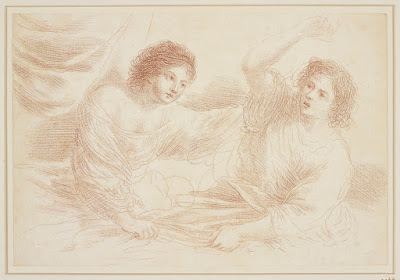 |
| Guercino (Giovanni Francesco Barbieri) The Horse Belladonna (lost painting, known from drawing) 1631 drawing Royal Library, Windsor |
"According to [Carlo Cesare] Malvasia, Guercino's lost portrait of the horse Belladonna, commissioned by Conte Filippo Aldrovandi, was painted from life. The count paid 31 scudi for it on 24 April 1631."
 |
| Guercino (Giovanni Francesco Barbieri) Portrait of Cardinal Bernardino Spada 1631 oil on canvas (trial version) Fabiano Forti Bernini Collection, Rome |
"This must be Guercino's small-sized oil sketch [directly above] for the more formal, half-length likeness [directly below] of Cardinal Bernardino Spada (1594-1661), now in the Galleria Spada, Rome. In the Cardinal's last year of tenure as Papal Legate of Bologna, a position he held from 1627 until 1631, he sent two courtiers to Cento to collect a painting of St. Luke [also below] and to bring Guercino back to Bologna to paint his portrait. . . . The artist probably made the oil sketch (as well as several preparatory drawings) on that occasion, for it seems unlikely that he would have begun the full-sized painted portrait on site: not only would the canvas have been too large to carry back and forth to Cento – especially if still wet – but this was the sort of picture he normally carried out in the studio."
 |
| Guercino (Giovanni Francesco Barbieri) Portrait of Cardinal Bernardino Spada 1631 oil on canvas (finished version) Galleria Spada, Rome |
 |
| Guercino (Giovanni Francesco Barbieri) Portrait of Cardinal Bernardino Spada 1631 drawing (figure study) Musée du Louvre |
 |
| Guercino (Giovanni Francesco Barbieri) St Luke 1631 oil on canvas private collection |
 |
| Guercino (Giovanni Francesco Barbieri) Alexander enjoining Silence on Hephaestion (lost painting known from drawings) ca. 1631 drawing Royal Library, Windsor |
 |
| Guercino (Giovanni Francesco Barbieri) Alexander enjoining Silence on Hephaestion (lost painting known from drawings) ca. 1631 drawing Royal Library, Windsor |
 |
| Guercino (Giovanni Francesco Barbieri) Alexander enjoining Silence on Hephaestion (lost painting known from drawings) ca. 1631 drawing Royal Library, Windsor |
"According to Plutarch's life of Alexander the Great, the King's mother, Olympias, often wrote private letters to her son, which he kept in a secret place. Once, his close friend Hephaestion, who had access to the King's state papers, saw one of Olympias's letters. Alexander allowed him to read it, but signified that he trusted his friend to keep its contents confidential by pressing the seal of his signet ring to Hephaestion's lips. A commission for a painting of this subject is recorded by Malvasia in the year 1631, from 'un Cavalier Bolognese'. The account book payment of 75 scudi for two half-length figures, received on 31 May 1631, identifies the client as Giovanni Battista Vaccari."
 |
| Guercino (Giovanni Francesco Barbieri) Joseph and Potiphar's Wife 1631 oil on canvas Fondazione Zanasi, Modena |
 |
| Guercino (Giovanni Francesco Barbieri) Joseph and Potiphar's Wife 1631 drawing (compositional study) Honolulu Museum of Art |
 |
| Guercino (Giovanni Francesco Barbieri) Joseph and Potiphar's Wife 1631 drawing (compositional study) Museum of Fine Arts, Boston |
 |
| Guercino (Giovanni Francesco Barbieri) Joseph and Potiphar's Wife 1631 retouched offset-drawing Royal Library, Windsor |
"Guercino painted the subject of Joseph and Potiphar's Wife twice in his career. In my opinion, his first treatment of the story is the canvas [above] now in the Zanasi Foundation, Modena, which Malvasia said was ordered from the painter in 1631 by a certain Giuseppe Fallia of Piacenza. Though Fallia placed the order, the account book payment of 130 scudi, made on 25 August 1631, was from Francesco I, Duke of Modena, who married Maria Caterina Farnese (1615-46), daughter of the Duke of Parma, on 11 January of that same year at a ceremony in Parma Cathedral. At the time Malvasia wrote his biography, the picture was hanging in the ducal gallery at Modena, then in the possession of Francesco I's grandson, Francesco II d'Este (reg. 1662-94)."
 |
| Guercino (or workshop, possibly Matteo Loves) Amnon and Tamar ca. 1631 or after oil on canvas Galleria Estense, Modena |
 |
| Guercino (Giovanni Francesco Barbieri) Amnon and Tamar ca. 1631 drawing (compositional study) Teylers Museum, Haarlem |
"In my opinion, the finish of the Modena Amnon and Tamar is too precise and polished, even static and frigid, to be by Guercino. Some details are too literal in their description, such as the leaves of a laurel tree in the right background – studiously painted one by one – and the dancing jewels on long stems that grow out from the side of [Tamar's] hair band. The glossy draperies and rotund figural forms, shaded like a shiny white porcelain vase, suggest the hand of Matteo Loves, though certainly produced while in Guercino's studio: not only is the painting probably based on one of the master's drawings, Tamar's gold damasked dress was one of Guercino's studio props."
– quoted texts from The Paintings of Guercino: a revised and expanded catalogue raisonné by Nicholas Turner (Rome: Ugo Bozzi Editore, 2017)